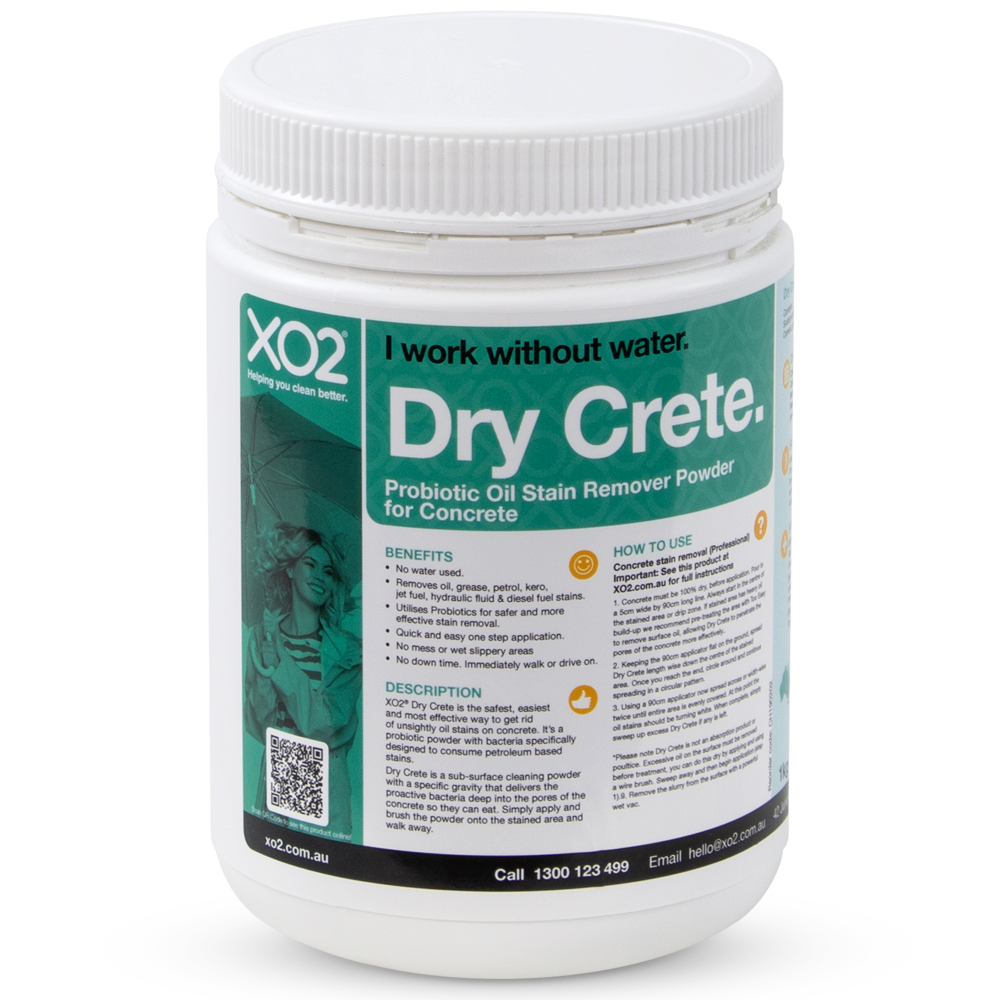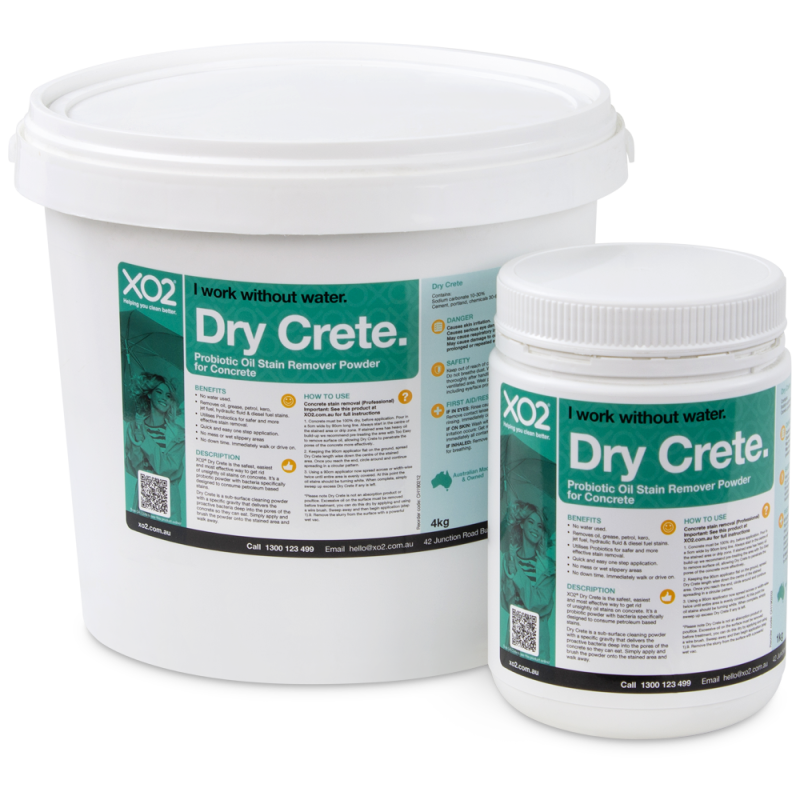Specifications for Dry Crete - Waterless Probiotic Oil Stain Remover & Cleaner for Concrete
I work without water.
What is the perfect oil stain remover for concrete? Want to apply and walk away? Like something where no scrubbing or rinsing is required? A dry process? Imagine friendly proactive bacteria that keep cleaning after you’ve gone! Oil stain removal from concrete will never be the same, here’s why...
Dry Crete is the safest, easiest and most effective way to get rid of unsightly oil stains on concrete when harsh chemicals, access to water and waste water runoff or removal is an issue. Dry Crete is a probiotic powder with friendly bacteria specifically designed to consume petroleum-based stains such as oil, grease, petrol, kero, jet fuel, hydraulic fluid and diesel fuel.
Say what?!!! Yep, we’re using good old natural bacteria to remove oil stains from concrete! Dry Crete is a sub-surface cleaning powder with a specific gravity that delivers the proactive bacteria deep into the pores of the concrete so they can eat. Simply apply and brush the powder onto the stained area and walk away.
Dry Crete eliminates the need for auto scrubbing, water blasting and water recovery equipment that lead to risks, mess and expensive shutdowns. Our biotechnology is incredibly safe for people, pets, plants, surfaces and the environment (cradle-to-cradle).
Because Dry Crete uses Probiotic technology it is accepted scientifically as a “time-driven” process whereby significant improvement will be visible within 24-72 hours.
The benefits
• Removes oil, grease, petrol, kero, jet fuel, hydraulic fluid and diesel fuel stains.
• Utilises Probiotics for safer and more effective stain removal.
• Quick and easy one-step application.
• No water used.
• No runoff or environmental pollution.
• No downtime. Immediately walk or drive on.
• No mess or wet slippery areas.
• Safe for people, pets, plants, surfaces and the environment.
• Huge cost and labour savings.
• Deep penetration into concrete pores.
• Made in Australia.
Environmental impact issues
1 litre of oil can contaminate approximately 400,000 litres of drinking water. There are over 1 billion vehicles that leak petroleum based fluids into the environment each year. Each time it rains, hydrocarbon petroleum material is being washed off concrete surfaces as “run off” and finds its way into the natural environment.
Until now well intentioned manufacturers of commercial chemicals, solvents and degreasers have been designing products to emulsify and solubilize oil, grease and petrol. Unfortunately for the environment and our precious water reserves very large quantities of “rinsing water” is required for this type of cleaning solution.
This process creates contaminated toxic waste water that finds its way into soil, storm water drains, sewage systems, underground water sheds, dams, river systems and into much larger bodies of water where organic life is being negatively impacted. Strict environmental and water usage regulations now mean severe penalties and fines are being enforced. Property owners and managers are now being held responsible for their water usage and the disposal of contaminated wastewater resulting from their property maintenance.
Facts about concrete
The pores in the concrete are roughly the same size as the pores of your skin. Water blasting and the use of degreasers only clean the surface, you can’t blast 3000psi of water pressure down into the pores of concrete and expect to completely remove the oil. There are over 200,000 pores per square metre of concrete.
Dry Crete is ready to use. Do not dilute. Dry Crete must be stored dry at a temperature of no less than 7°C. Shelf life is one year when stored under proper conditions. You can walk or drive on the surface immediately after or even during application. No need to wait.
Oil stain removal from concrete
1. Concrete must be 100% dry, before application. Pour in a 5cm wide by 90cm long line. Always start in the centre of the stained area or drip zone. If the stained area has heavy oil build-up we recommend pre-treating the area with Too Easy to remove surface oil, allowing Dry Crete to penetrate the pores of the concrete more effectively.
2. Keeping the 90cm applicator flat on the ground, spread Dry Crete lengthwise down the centre of the stained area. Once you reach the end, circle around and continue spreading in a circular pattern.
3. Using a 90cm applicator now spread across or width-wise twice until the entire area is evenly covered. At this point, the oil stains should be turning white. When complete, simply sweep up excess Dry Crete if any is left.
*Please note Dry Crete is not an absorption product or poultice. Excessive oil on the surface must be removed before treatment, you can do this dry by applying Dry Crete and using a wire brush or stiff broom. Sweep away and then begin application (Step 1).
Handy tips
• Only apply to a dry surface.
• The more porous the concrete is, the faster and more effective Dry Crete will be because it will have greater contact with the staining.
• Dry Crete is made of all-natural ingredients that are environmentally friendly so it will not damage painted lines, landscaping, metal surfaces or plants.
How does the Dry Crete process compare to traditional high-pressure water blasting?
The best way to answer this is to do a comparison between the two. Let's do it...
Dry Crete
• Coverage/labour: 550m² per hour
• Set up time: 5 minutes
• Shutdown/pack-up time: 10 minutes
• Slip hazards: None/Dry
• Water usage/runoff: None
• End result: Stains initially turn white. Deep penetration into pores. The probiotic process continues to dissipate oil after application. The area can be used immediately.
High-pressure water blasting
• Coverage/labour: 185m² per Hour
• Set up time: 15-20 minutes
• Shutdown/pack-up time: 30 minutes
• Slip hazards: Slippery/Wet
• Water usage/runoff: Yes. Bunding and drain protection are required.
• End result: Leaves light brown stains. Removes surface oil only. Starts re-soiling immediately. The area must be closed until the surface is dry.
Will I see results quickly?
No, the biological process takes 24-72 hours for you to see the results. This technology uses microscopic proactive bacteria to remove the soil. They need time to work and eat. If applied correctly and the porosity of the surface allows Dry Crete in, you will see some immediate improvement to the concrete. Some heavier, older and deeper stains may take 2 or 3 applications.
How does Dry Crete work?
It works with the help of specific gravity to pull the probiotic cleaning agents down into the pores where the oil is trapped. Dry Crete then breaks down and eats the hydrocarbon chain of petroleum-based stains.
What is the coverage rate?
Coverage for Dry Crete will vary according to the finish, texture and porosity of the concrete surface. Typically, 1kg of Dry Crete will cover 40m² to 60m² of concrete that has been steel trowel finished.
What do you need for a Dry Crete application?
All you need is some Dry Crete and a soft-bristled broom.
Will Dry Crete remove impossible oil stains every time?
No. Dry Crete will work almost all of the time but some staining on particular surfaces is beyond any method of removal. In these cases, replacement or resurfacing of the surface will be required.
How do XO2 probiotic cleaners work?
XO2 Probiotics are friendly microbes and enzymes whose favourite food is gunge and filth. During and after cleaning our little 'all natural' heroes start to work by breaking down and gobbling up grime. The final result is CO2 and water. As long as there is a food source the probiotics will continue to work. That means surfaces keep getting cleaner and stay cleaner for longer.



